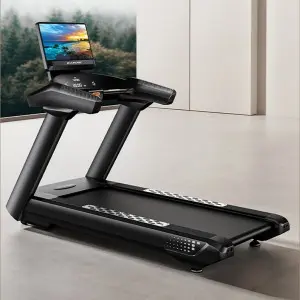Among the many key elements of commercial treadmills, the shock absorption system plays a crucial role, as it directly affects the user’s exercise experience and health.
In terms of principle, the common shock absorption methods mainly include mechanical shock absorption, rubber shock absorption and airbag shock absorption. Mechanical shock absorption usually utilizes mechanical structures such as springs to cushion impact forces. When a runner’s feet fall, the deformation of the springs absorbs part of the force, thereby reducing the impact on the joints. This shock absorption method has a long history, mature technology and relatively low cost, and is quite common in some mid-to-low-end commercial treadmills. However, it also has certain limitations. After long-term use, the spring may become fatigued, resulting in a decline in shock absorption effect.
Rubber shock absorption relies on the elasticity of rubber materials to achieve buffering. High-quality rubber has excellent resilience and durability, and can effectively disperse the impact force generated during running. Many commercial treadmills are equipped with rubber pads between the running board and the frame, or use rubber columns as support to achieve the purpose of shock absorption. The advantages of rubber shock absorption are low noise, relatively small impact on the environment, and the characteristics of rubber enable it to adapt to different temperature and humidity conditions, with high stability. However, as the usage time increases, the rubber may age, affecting its shock absorption performance.
Airbag shock absorption is a relatively new technology. It absorbs impact force by setting airbags under the running plate and taking advantage of the compressibility of gas. When runners are exercising, the airbags will automatically adjust according to pressure changes, providing more precise and comfortable shock absorption. The advantage of airbag shock absorption lies in its ability to adaptively adjust according to the user’s weight and exercise intensity, providing good protection for different people. However, its manufacturing process is rather complex and the cost is relatively high, which also makes commercial treadmills with airbag shock absorption generally more expensive.
The shock absorption system plays an indispensable role in the health of users. During running, every step that lands generates a considerable impact force. Without a good shock absorption system, these impact forces will be directly transmitted to joints such as the knees and ankles. Long-term accumulation may lead to joint damage. An excellent shock absorption system can effectively reduce this impact force, lower the risk of joint injuries, and enable users to exercise more safely and comfortably.
At the same time, a good shock absorption system can also enhance the sports experience. When running without feeling strong vibrations and impacts, users can more easily immerse themselves in the exercise, reduce fatigue caused by discomfort, and thereby enhance the durability and effectiveness of the exercise.
For commercial venues, choosing a treadmill with a high-quality shock absorption system not only provides better service to customers but also reduces damage to the equipment caused by frequent use and vibration, lowers maintenance costs, and extends the service life of the equipment.
When choosing a commercial treadmill, it is essential to fully consider the type, performance and reliability of its shock absorption system. Based on your own budget and usage requirements, select the most suitable product to create a safe and comfortable exercise environment for users.
Post time: Jul-11-2025


